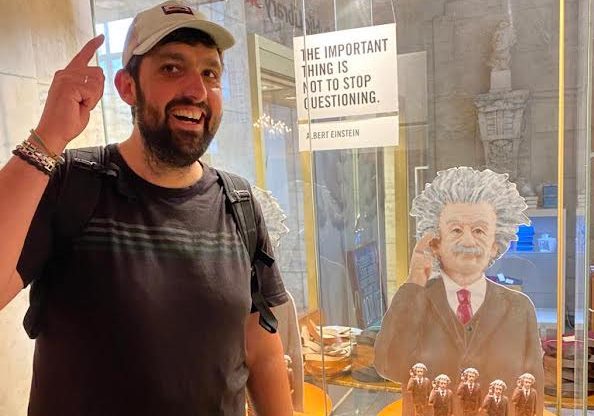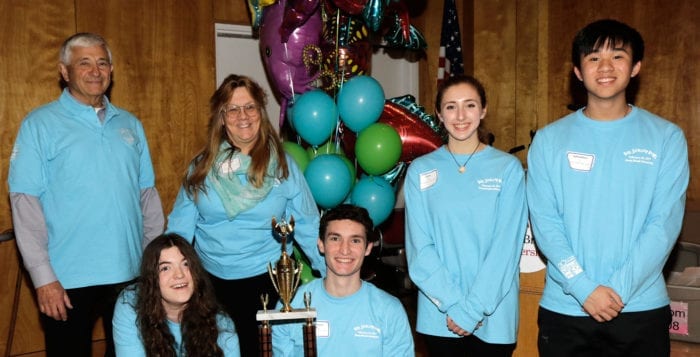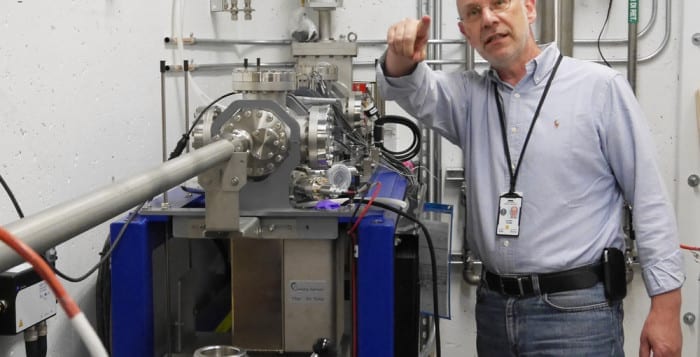By Daniel Dunaief
When he’s looking to relax, he builds and rebuilds some of the LEGO sets in his house in East Setauket. One of the things he likes best about being on Long Island, where he’s lived for the last two years, is that he can be alone to think and develop new ideas.
To hear Jesús Pérez Ríos describe himself, he is “just a kid having fun.” An Assistant Professor in the Department of Physics and Astronomy at Stony Brook University, Pérez Ríos enjoys bridging scientific knowledge, applying his physics background to questions, problems and puzzles in other fields.
Recently, the Stony Brook physicist, who is also an affiliated faculty member at the Institute for Advanced Computational Sciences, collaborated with Stefan Willitsch, Professor in the Department of Chemistry at the University of Basel in Switzerland, to explore the forces that might be inhibiting the reaction between hydroquinone and neon.
In a paper published in the journal Nature Chemistry, Pérez Ríos, Willitsch and members of their teams described in detail several potentially opposing forces that affect the reactivity in the experiment.
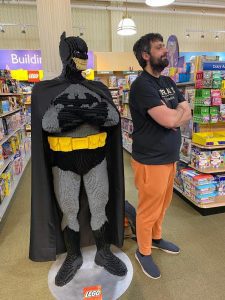
“I started collaborating with [Willitsch] because he had accurate results, and it was hard to explain the observations,” said Pérez Ríos. “We had a hypothesis but needed to develop models to test it.”
Pérez Ríos described two interactions in detail. One is due to the long range atom-molecule interactions and the other comes from internal rotational dynamics.
With the experiments in Willitsch’s lab and the theory developed by Pérez Ríos and his colleagues, they highlighted the role of rotational quantum states in a hydroquinone-neon chemi-ionization reaction. A similar mechanism and approach may be suitable for other reactions as well, such as molecular ion-atom reactions.
These molecules are akin to puzzle pieces coming together. Instead of a two-dimensional alignment where pieces find each other and lock together in their complementary parts, these pieces also have rotational effects that can cause a misalignment.
“That is one of our key findings,” Pérez Ríos explained. “It is like the shape of the puzzle piece evolves depending on the molecule’s collision energy and internal state.”
The results presented in the scientific paper are in the realm of fundamental research, with no “immediate practical application in synthesis or catalysis,” explained Willitsch.
Nonetheless, the insights gained through this collaboration “leads to a better understanding of the relevant reaction mechanisms and thus enables a more efficient design of future chemical reactions.”
At this point, Willitsch has presented the work at several conferences, where he has found a receptive audience and expects it will “foreseeably stimulate further work in the field.”
A search for answers
Pérez Ríos explained that Willitsch had some possible explanations for his data, but he did not have a mathematical model to test his hypothesis.
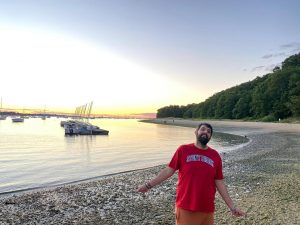
“He mentioned the experimental details to me and we discussed the data,” said Pérez Ríos, who has known Willitsch for about 12 years. “Then, we started to do calculations from our side.”
Pérez Ríos has a team of 7 PhD students, one postdoctoral researcher, one Master’s candidate and three undergraduates.
Members of his lab work on simulations of physical phenomena regarding atomic and molecular processes. Additionally, they work on machine learning applications to atomic and molecular physics, exploring ways to teach a machine classical mechanics or quantum mechanics through chemical reactions.
In the reaction he was studying, Willitsch was working with hydroquinone, which has two conformers. These are two molecules with the same chemical formula that have two different structures.
Willitsch was able to select for a particular type of conformer in its reaction with neon.
Pérez Ríos considered many possibilities and models, none of which was fully satisfactory.
An insight at a conference
When he was at an Air Force Office of Scientific Research review program in Washington DC, Pérez Ríos was considering the problem from numerous perspectives.
He had tried many possibilities, but none were convincing. He needed something new.
“I had the physical picture of the model during a conference: in a break, I started to work on the code, and, in a few hours, I had something ready to get some very preliminary results,” Pérez Ríos recalled.
Willitsch enthusiastically embraced the preliminary results and the group decided to make it more realistic, developing the version of the code to explain Willitsch’s data.
The dynamics simulations were ready in a month, with extra checks conducted for another month to ensure everything was correct. The joint effort took over a year and a half to produce a fulfilling explanation.
Many of Pérez Ríos’s collaborators come from different disciplines, which gives the Stony Brook Assistant Professor an opportunity to learn about a variety of topics. He has worked with particle, atmospheric, atomic and plasma physicists and spectroscopists and chemists.
Pérez Ríos suggested that a physics perspective can help in a variety of settings, even including household problems and daily challenges.
Echoing a theme from the main character Jason Nesmith (played by Tim Allen) in the movie Galaxy Quest, Pérez Ríos said, “you can never surrender.”
Pérez Ríos added that you “are the only one putting limits on yourself. However, you need to pick the battles worth fighting, which is a very difficult matter.”
More American than Americans
A resident of East Setauket where he lives with his wife Anne Martinez Hoth, Pérez Ríos grew up in Guardamar del Segura, a small town in Alicante, Spain.
The son of restaurant owners, Pérez Ríos said he didn’t travel during summers to the beach, the way many of his friends did.
When he wasn’t helping in the restaurant, he used his free time to learn about math, zoology, genetics, chemistry and physics.
He enjoys living on Long Island and in the United States. His wife suggests he is “more American than the Americans” because he likes the American job philosophy and the freedom.
At Stony Brook, Pérez Ríos teaches quantum mechanics to undergrads, some of whom say he is strict.
“I have a very particular approach focusing on learning to think rather than knowing how to solve a problem,” he said.
As a research partner, Pérez Ríos is an unusual find, bringing constructive and valuable insights to discussions.
“I have rarely collaborated with someone so energetic and broadly interested” as Pérez Ríos, Willitsch said. “I particularly value his pragmatic approach and that he is not afraid to leave his comfort zone to delve into totally new classes of problems, which have not been tackled before either by himself or others.”
Willitsch added that few scientists have the same broad knowledge of physics and chemistry, which is “vital to push this interdisciplinary frontier.”

